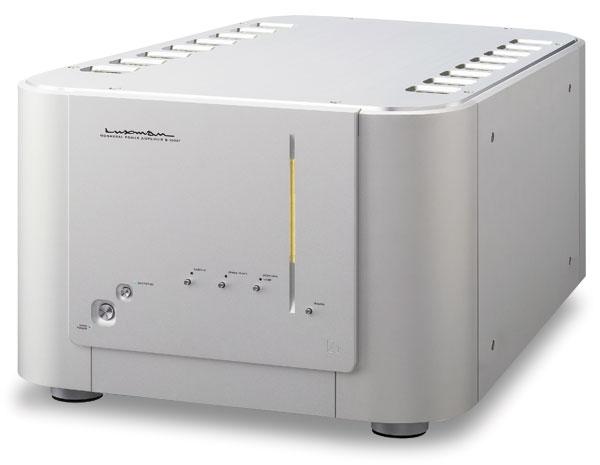| Columns Retired Columns & Blogs |
How can one comment on this .
It's big , it's beautiful , and it's unaffordable .
Great review though Wes .

When O'Hanlon told me the price of the stands—$2500/pair—I asked what the amps cost.
"Fifty-five," he said.
"You mean the stands are 45% of the price of the amps?"
"That's fifty-five thousand," he said.
Oh. Either the B-1000Fs were going to be revelatory, or they were going to unmask the greed of the ultra-high-end. One way or another, this was going to be a fun review.
It is impossible to overdo luxury
The B-1000F was developed as the 80th-anniversary flagship product for the venerable Japanese manufacturer. Fifteen years of planning and development went into the design, and no detail was considered too minor for scrutiny by Luxman's director of research and development, Youichi Hashimoto.
O'Hanlon told me that the heart of the B-1000F is its transformer. It is wound with flat, 2mm-thick copper bar, insulated with paper, that is meticulously hand-hammered around the core. Luxman entrusts this to a single craftsman. His entire week's output is three transformers.
The transformers sit on the B-1000F's vibration-isolation chassis base. Each section of the amp is isolated from the others by shielding and internal filtering. Circuit boards are laid out to avoid right angles in the traces—the Luxman engineers have their reasons for this, but what it really comes down to is that they prefer this layout's sound. Luxman claims that all of the passive components in the B-1000F's circuits are of the highest quality and are chosen for their sound, not just their specs. Bus bars of solid copper connect the transformers to other circuit components.
The B-1000F also employs Luxman's proprietary Only Distortion Negative Feedback (ODNF) topology, which isolates noise and distortion from the music signal at the output, "sparingly applying negative feedback to suppress them." (This and further details available here.)
In the lower left corner of the B-1000F's front panel is a large power switch, flanked by a standby button. There are also tiny pushbuttons for choosing the balanced inputs (it's a fully balanced design, so this is the recommended mode), absolute phase, and 4dB of attenuation. A vertical yellow thermometer display indicates the power output. For those who find this distracting, another button turns off the display. (From my experience as an audio salesman, fewer people are bothered by the workings of a power meter than are disappointed by how little it moves during what they conceive to be musical passages of great dynamic range.)
The rear panel boasts the largest, sturdiest binding posts I have ever seen, as well as balanced and singled-ended inputs, RJ-11 ports, and an IEC power socket. That socket is worth mentioning; it, too, reveals Luxman's fanaticism for detail. Its conductive parts are milled from nickel-plated brass, which is then plated with gold. There's also a Line Phase Sensor—engage it, and it will warn you if your house's AC circuits have the Live and Neutral swapped.

The B-1000F is claimed to output 250W (the first 30W in class-A) into 8 ohms, 500W into 4 ohms, 1000W into 2 ohms, and 2000W into 1 ohm. That power doesn't come cheap—and I'm not just talking sticker price. Each amp draws 439W from the wall, which means it turns a lot of that power into heat, even at idle. Put it in Standby and you'll keep the vital circuits warm while drawing only 1W or so. However, the B-1000F does take a while to warm up to optimal sound quality from Standby. Relax, pour an adult beverage, and choose some music for the upcoming listening section.
The build quality is impressive. Each B-1000F is constructed to the highest standard of audio bling, from its thick aluminum chassis to its vented top plate—this is one amp you won't want to hide, even if you could. You may find yourself patting its curved flanks, just for the tactile satisfaction.

Other than its heat output at idle (and the concomitant cost of electricity) and the minor problems of dealing with such massive gear (we should all have such problems), setup and use of the B-1000F were simple and straightforward.
Luxury must be comfortable
When O'Hanlon first installed the B-1000Fs, we were listening to Vivid Audio's G1Giya loudspeakers, which I'd heard before but not in my own listening room (see my review in the July 2010 issue). I was immediately struck by the solidity of the Luxman-Vivid combo—even at the volume levels at which O'Hanlon demos! As the amps settled down, this quality got even better; and when, later that evening, John Atkinson arrived with some hi-rez piano recordings he'd engineered himself, the Luxmans were provoking a jump factor that was uncanny.

Great review. I love the clean aesthetics. I had a Luxman D-113D CD player back in the early 90's. It was a great CD player.

A great review puts you in the room with the reviewer. This was a great review. The amp sounded awesome!

I re-read the print review for kicks, and the explanation JA gave was very educational. Seeing the information transition from figs 1 to 2, as well as the generally informative figs 3 and 4, I can see very clearly his references.
I really want that Gabriel tune- it didnt come on the LP!

You can trust Mr. Phillips opinion in the sound of the Luxman. I will never know unless I run accross it at a show or dealer. If it cost as much as some undesirable homes and desirable cars, it should sound better than a great cheaper but fine Parasound Halo. If you don't have a nice car or home, maybe you should not buy it. To me, my system would get more use than my automobile. But singularly height of the amp would cause me to overlook it as if I could acquire it. Though love the way Luxman keeps its guts separated!